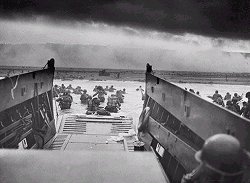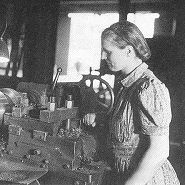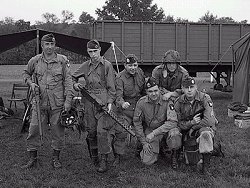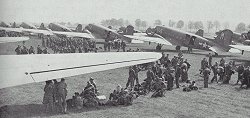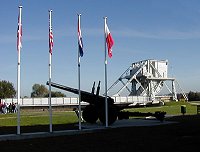D-DAY
Watch our four part mini series of films showing how Swindon played its part on the 6th June 1944.
To commemorate the 70th anniversary of D-Day in 2014, we put together a special four-part mini series of films chronicling how Swindon and the surrounding area played a crucial part before, on and straight after the most important day of World War Two.
And with the
81st
anniversary almost here, it's only fitting we post them again.
Watch the complete series below or view the individual parts.
PART ONE: INTRODUCTION & RAF Blakehill Farm, Cricklade
PART TWO - Aldbourne
Home to Easy Company of the US Army 101st Airborne Division, who trained here in the months before D-Day and who's story was made famous by the HBO series Band of Brothers.
PART THREE - RAF Wroughton & The Swindon Works
The airfield that looks down on Old Town, Swindon, where over 600 Horsa Airspeed wooden gliders that transported troops into Normandy during D-Day were built by local furniture makers incl. craftsmen from Gilberts of Swindon. Plus the Swindon Works where, as part of a massive war effort, significant numbers of landing craft used during the invasion were built.
PART FOUR - Chiseldon Camp & Lydiard Park
We also had the great pleasure of interviewing Bob Noody from Fox Company, 506th PIR, 101st Airborne whilst he was visiting Aldbourne. See the interview below.
And just look at the transport we used!
Huge thanks to historian Bill King and our DDay sponsors Gilberts of Swindon for helping us make this happen.
Swindon & D Day
It's remarkable that a single day could write so many footnotes in the history of the world.
June 6th, 1944 was that day - 78 years ago. Countless tales arose from D-Day and its aftermath, but it is possible to make out two distinct themes to the big picture. It will certainly go down as the day when thousands made the ultimate sacrifice - to be followed by many thousands more in the following days, weeks and months. Their heroism and their honour is obvious - and history will ensure that what they did will never be forgotten. But D-Day is also remembered for its complexity and the collective contributions of many more who not only made the greatest invasion of all time possible, but somehow made it a success.
GWR Works Played Key Role
Swindon was at the heart of that
achievement and the town, the surrounding area and its people all had important roles to play. The town was never meant to produce military heroes and, indeed, actually threw up less individual heroes than other towns of its size.
This was because it was dominated by its huge railway works, which provided the overwhelming majority of employment in the town, and much of its workforce was exempt from military service in the Second World War. Skilled railway jobs were classed as reserved occupations because making sure the railway network ran smoothly was a key aspect of the war effort on the Home Front - and never more so than in the run-up to D-Day. That's not to say that the town was short on sacrifice as many skilled railwaymen found themselves uprooted from their homes and families and despatched to other industrial centres across the country.
Female workers were drafted into the GWR factory to fill the gaps - producing a culture shock for them and the men who stayed in Swindon. If the details of the war work carried out in Swindon Works is sometimes sketchy as a result of wartime secrecy, the scale of it is unmistakable.
As early as 1940, GWR workers were designing and manufacturing bombs weighing up to 4,000lbs, eventually turning out tens of thousands. Over 60,000 shells, nearly 200,000 aircraft parts and countless components for tanks, armoured cars and other military vehicles also rolled off the Swindon production line. The diversity of the work is as impressive as the scale. The factory turned out midget submarines, searchlight projectors, generators for new-fangled radar systems and endless milled components that were liable to end up in all manner of military hardware. D-Day was, in many ways, the culmination of years of toil by Swindon folk - and some of the now familiar images of the invasion exist because of preparations carried out in the town.
Balloons, Bridges and Landing Craft
Many of the barrage balloons that protected the invasion force as it assembled and then mobilised, for instance, included quick-release gears made in Swindon - nearly 22,000 sets in all - while Bailey bridges, which formed a key part of the logistics effort soon after D-Day, included a total of 27,000 Swindon-made components.
But perhaps the greatest symbol of the beach landings was the armada of 4,000 landing craft, and these included many built in Swindon Railway Works. Ironically, they were too wide for transport by railway and had to be despatched from Swindon to the south coast by road.
The aspect of the invasion that is perhaps the most difficult to imagine, 60 years on, is the sheer noise created by the aerial bombardment of the Normandy coast - and this, too, was also partly thanks to Swindon as its railway works produced a large number of naval guns and components. If D-Day had followed the plan that the enemy had expected, and come from Kent, what was arguably Swindon's most unusual contribution to the war effort would also have seen action. Working under the strictest secrecy and security, Swindon railway workers produced the designs and mountings for a hyper-velocity gun, designed to fire across the narrowest part of the Channel. What needs stating at this point is that despite all the innovative war work being carried out in the factory, it also had to continue to fulfil its crucial function as a railway centre ≠ and in ever-difficult circumstances. Not only were key skilled workers missing, but black-out conditions made it difficult to maintain the high standards of workmanship that had made Swindon a by-word for quality in the pre-war years. Shortages of metal produced more challenges and the constant running of machinery and rolling stock added still further to the problems faced. In fact, railway production was virtually suspended during the war years as maintenance became its most important role.
Band of Brothers
As 150,000 soldiers were assembled in southern England in May and June 1944, ready for D-Day, Swindon, more than ever, became a hub of a railway network that would be tested to extremes.
No wonder the town also found itself ringed by military camps, which were brimming over with men in the days leading up to D-Day, while the makeshift hospitals that also sprang up in the area were to find themselves equally busy once the invasion was underway.
All these camps have their own fascinating histories, including the long-established camp at Burderop near Chiseldon and the Princess Alexandra RAF hospital. The Lawn manor house in Old Town (formerly the home of the Goddard family) and Drove Road Senior School all accommodated American servicemen in 1944 much to the delight of the local female population, including a very young Diana Dors, who often spoke fondly of being given chocolate by the GIs 'up the road' from her Marlborough Road home.
There was even a temporary camp and hospital at Lydiard Park - on the land now used for sports, to the left of the drive at the Hook Street entrance to the park. The hospital chapel and mortuary were roughly where today's Visitor Centre stands.
The camp was destined to be converted to a prisoner of war camp for Germans captured during the liberation of Europe, but, on D-Day, its hospital was preparing to receive casualties from the American 101st Airborne Division. It was part of this division, called Easy Company, that had been stationed at Aldbourne before D-Day and have now been immortalised in the American TV series, Band of Brothers.
In fact, Aldbourne was only one of many towns and villages in the area ≠ and across the south of England ≠ which played host to Allied troops awaiting the D-Day go-ahead in what soldiers came to know as 'sausage camps' (because of the sausage-shaped marks used to identify them on military maps).
Many troops were also billeted in Swindon itself, while the town would have been familiar to many of those stationed in the surrounding towns and villages as an obvious place to head for during their free time ≠ including the extended leave period that some units were granted in the first week of June.
Skies Over Swindon
Swindon was also surrounded by key airfields and these were important not only for the transport of paratroops and other military personnel on D-Day, but also the return of wounded troops, post-D-Day.
Blakehill Farm, near Cricklade, was the base for two RAF squadrons and was one of the eight airfields from which planes flew directly to Normandy on the night of 5th June, 1944 when Dakotas (see pic below) towed glider troops aiming for Pegaus Bridge. It was also to record two notable firsts in the coming days.
Blakehill-stationed nurses who looked after wounded soldiers on returning flights became the first female RAF aircrew to fly into the combat zone (see pic. below), while a Dakota from Blakehill's No. 233 Squadron became the first aircraft to land at a British-controlled airstrip in France after the invasion, touching down on 13th June.
D-Day casualties
The US 130th Station Hospital had officially opened at Chiseldon Camp on 03 October 1943, with most of its early patients suffering from training injuries, but in June 1944 the hospital became a key location for the handling of casualties arising from the D-Day landings.
It was a transit centre, receiving casualties evacuated directly from the battle zone - either by rail or on USAF Dakotas via airfields at Blakehill near Cricklade, Lyneham, Down Ampney and Broadwell Membury.
This evacuation couldn't begin until long runways had been established in Normandy, so the first casualties - 455 of them - arrived on 13 June, 1945, 7 days after the invasion began.
In the six months between then and January 1, 1945, the hospital received 30,321 casualties from Belgium and France, of whom only 12 died. The less successful - but no less glorious - raid on Arnhem in September 1944 (the so-called 'bridge too far') would also be launched from Blakehill. June 1944 was a busy time for all of Swindon's airfields and a measure of the scale of the operation is that on the eve of D-Day, there were nearly 600 aircraft on site at RAF Wroughton, which was both an operational airfield and home for a maintenance unit. Manufacture of some of the aircraft which supported the invasion was also a local affair.
Huge Hamilcar tank-carrying gliders were assembled at RAF Lyneham for use on D-Day, while RAF Wroughton assembled a large proportion of the Airspeed Horsa troop-carrying gliders that were to not only play a key role in the D-Day offensive, but were involved in the very first assaults.
It is likely that the gliders involved in the famous moonlit raid on the key Pegasus Bridge over the Caen Canal were put together at Wroughton.
Connections live on
Pontorson is close to the Normandy-Brittany border and had to wait until the first week of August before it was liberated by the Americans - but in doing so it saw the beginning of a legendary chapter in American military history. It was here that a certain General George S Patton entered the fray for the first time by securing a bridgehead over the Couesnon River with his 'Hell on Wheels' Division.
|
|
||||||||
|
RAF Blakehill |
||||||||
|
Alan Fowler |
||||||||
|
The Yanks are Coming!... |
||||||||
|
Swindon on D-Day |
||||||||
|
Flying Nightingales |
||||||||
|
||||||||
|
||||||||
|
||||||||
|
||||||||
|
||||||||
|
||||||||
|
||||||||
|
||||||||
|
||||||||
|
||||||||
|
||||||||
|
||||||||
|
||||||||
|
||||||||
|
||||||||
|
||||||||
|
||||||||
|
||||||||
|
||||||||
|
||||||||
|
||||||||
|
||||||||
|
||||||||
|
||||||||
|
||||||||
|
||||||||
|
||||||||
|
||||||||
|
||||||||
|
||||||||
|
||||||||
|
||||||||
|
||||||||
|
||||||||
|
||||||||
|
||||||||
|
||||||||
|
||||||||
|
||||||||
|
||||||||
|
|||||||||








